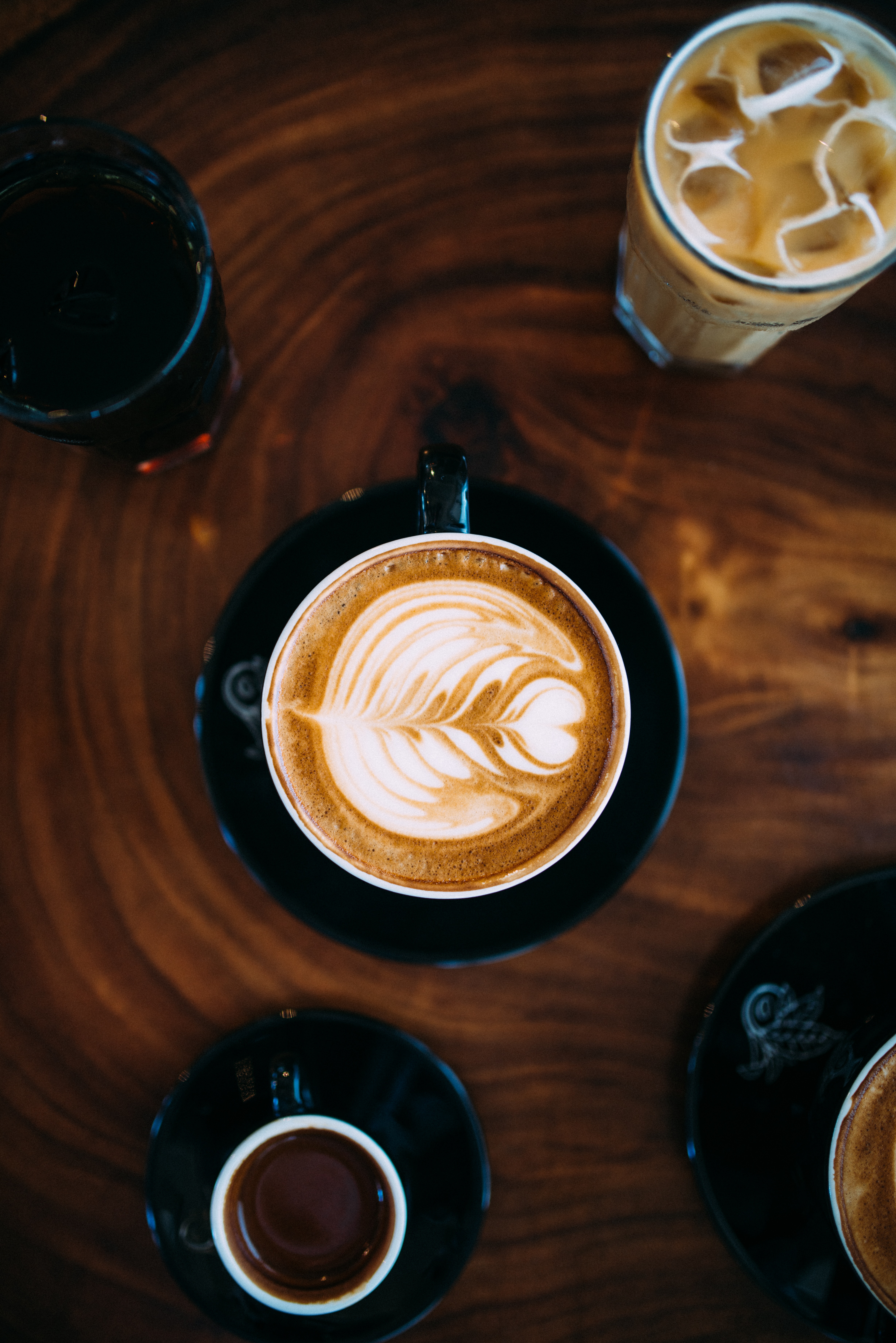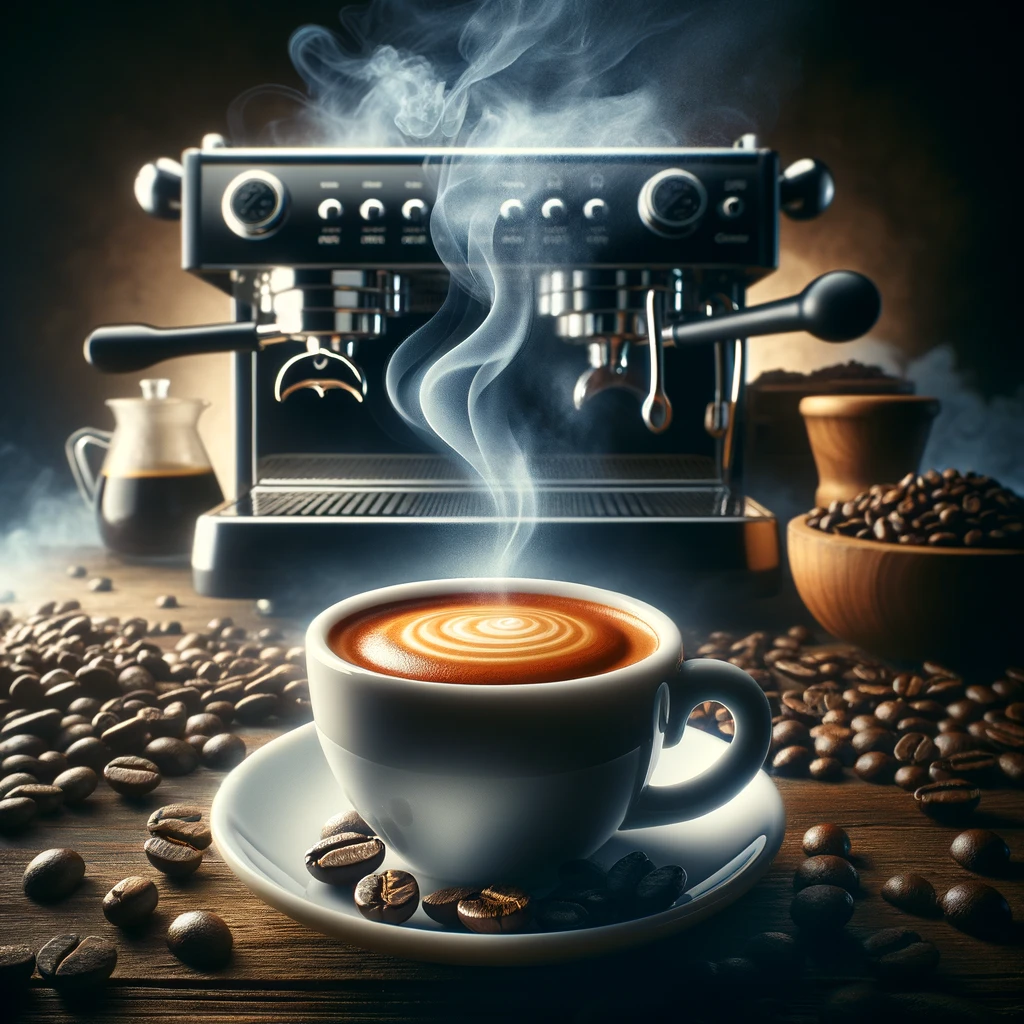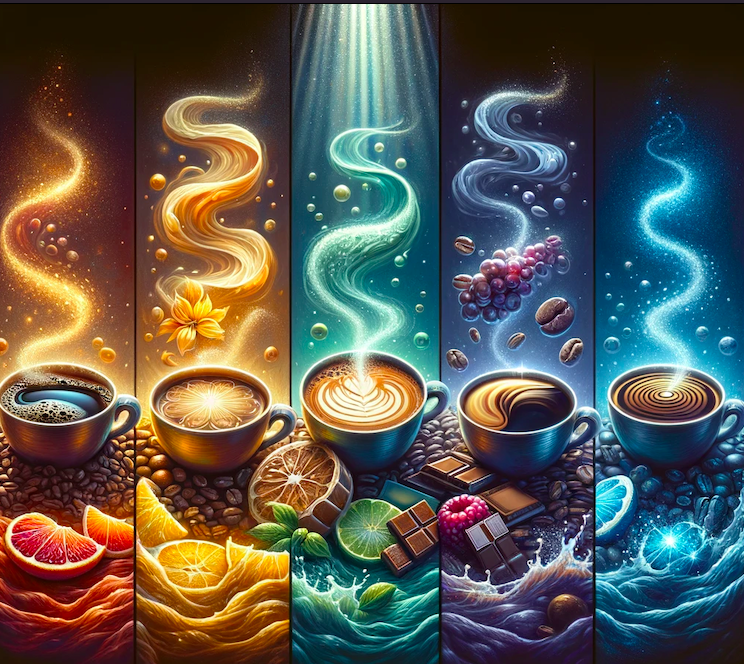This post may contains affiliate links which means I may receive a commission from purchases made through links. Learn more on my affiliate disclaimer.
The Origins of Espresso vs Coffee Beans
The history of espresso and coffee beans dates back centuries, with both having distinct origins. Espresso originated in Italy during the 19th century, where it quickly gained popularity for its strong flavor and quick brewing process. Coffee beans, on the other hand, have a much longer history that can be traced back to ancient Ethiopia.
Espresso is made by forcing hot water through finely ground coffee beans at high pressure. This results in a concentrated shot of coffee with a rich flavor and thick crema on top. In contrast, regular brewed coffee involves steeping coarser grounds in hot water for a longer period of time.
The different brewing processes contribute to the unique flavor profiles of espresso and regular coffee. Espresso tends to have a bolder taste with notes of caramel, chocolate, and even fruitiness depending on the type of bean used. Regular brewed coffee often has a milder flavor profile that can vary based on factors such as roast level and origin.
Overall, understanding the origins of espresso vs coffee beans provides valuable insight into their distinct characteristics. Whether you prefer the intense flavors of espresso or the more subtle nuances found in regular brewed coffee, both options offer an enjoyable way to savor one of life’s most beloved beverages.
Understanding the Brewing Process of Espresso and Coffee Beans
Espresso vs coffee beans both go through a brewing process that brings out their distinct flavors and aromas. The first step in this process is grinding the beans to the desired consistency. For espresso, a fine grind is used to maximize surface area contact with water during extraction, while for regular coffee, a coarser grind allows for slower extraction and a more balanced flavor.
Once the beans are ground, they are placed in brewing equipment specific to each method. For espresso, hot water is forced through tightly packed grounds under high pressure, resulting in a concentrated shot of rich, full-bodied coffee. On the other hand, regular coffee is brewed by pouring hot water over grounds in a filter or using an immersion method like French press. This allows for longer extraction time and produces a larger volume of milder-tasting beverage.
Temperature control also plays an important role in the brewing process. Espresso requires water at around 195°F (90°C) to extract flavors properly without scorching the grounds. Regular coffee can be brewed at slightly lower temperatures between 195-205°F (90-96°C), allowing for different levels of acidity and body depending on personal preference.
By understanding these key aspects of the brewing process for espresso vs coffee beans, you can better appreciate their unique characteristics when enjoying your favorite cuppa. Whether you prefer the intense boldness of espresso or savoring a comforting mug of regular joe, experimenting with different variables such as grind size and temperature will help you tailor your brew to perfection.
The Flavor Profiles of Espresso vs Coffee Beans
The flavor profiles of espresso vs coffee beans offer distinct characteristics that appeal to different taste preferences. Espresso is known for its bold, intense flavor with a rich, full-bodied taste. The concentrated brewing process extracts the oils and flavors from the finely ground coffee beans, resulting in a strong and robust cup of coffee. The flavor profile of espresso often includes notes of chocolate, caramel, and dark fruits.
On the other hand, regular brewed coffee offers a wider range of flavors due to its longer extraction time. Coffee beans used for drip brewing or French press methods produce a milder taste compared to espresso. The flavor profile of brewed coffee can vary depending on factors such as bean origin, roast level, and brewing technique. It may exhibit notes of nuttiness, citrus fruits, floral undertones or even earthy tones.
Roasting techniques also play a significant role in shaping the flavor profiles of both espresso vs coffee beans. Darker roasts are commonly used for espresso as they enhance the intensity and bitterness desired in this brew method. These roasts bring out smoky or burnt flavors while maintaining the natural sweetness found in certain types of beans.
In contrast, lighter roasts are popular among those who prefer brewed coffee as they highlight more delicate flavors present in the beans without overwhelming them with excessive bitterness or smokiness. Lighter roasted coffees tend to have brighter acidity levels which contribute to their vibrant flavor profiles.
Understanding these unique flavor profiles allows enthusiasts to appreciate both espresso’s strength and complexity as well as brewed coffee’s diverse range of tastes. Whether one prefers an invigorating shot or a comforting mugful depends on personal preference but exploring both options provides an opportunity to savor different dimensions within the world of caffeine-infused beverages.
The Different Roasting Techniques for Espresso vs Coffee Beans
Roasting is a crucial step in the coffee production process that greatly influences the flavor and aroma of both espresso vs coffee beans. Different roasting techniques are employed to achieve varying degrees of roast, ranging from light to dark. Light roasts preserve more of the bean’s natural flavors, while dark roasts develop rich, smoky notes.
One popular technique is called “city roast,” which involves heating the beans until they reach a medium brown color. This results in a balanced flavor profile with moderate acidity and sweetness. Another technique is known as “full city roast,” where the beans are roasted slightly longer to produce a darker brown color and fuller body.
For those who prefer stronger flavors, there is also the option of dark roasts such as French or Italian roast. These involve extended roasting times that result in deep, bold flavors with low acidity but pronounced bitterness. The longer exposure to heat caramelizes sugars within the beans, creating complex taste profiles favored by many espresso enthusiasts.
Overall, understanding different roasting techniques allows coffee lovers to explore an array of flavors and find their preferred cup of joe or shot of espresso. Whether it be a light city roast for delicate nuances or a robust dark roast for intense richness, each technique offers its own unique experience for indulging in these beloved caffeinated beverages.
Exploring the Brewing Equipment for Espresso vs Coffee Beans
Exploring the Brewing Equipment for Espresso vs Coffee Beans
When it comes to brewing espresso or coffee, having the right equipment is essential. The first piece of equipment that comes to mind is the coffee machine. For espresso, a high-quality espresso machine is necessary. These machines use pressure to force hot water through finely ground coffee beans, resulting in a rich and concentrated shot of espresso. On the other hand, for regular brewed coffee, a drip coffee maker or French press can be used.
In addition to the coffee machine, another important piece of brewing equipment is the grinder. Whether you’re making espresso or regular coffee, grinding your beans fresh before each brew is crucial for achieving optimal flavor. A burr grinder is recommended as it provides a consistent grind size and prevents overheating of the beans during grinding.
Lastly, don’t forget about accessories such as tamper and scales. For espresso brewing, a tamper helps evenly distribute and compact the ground coffee in the portafilter basket before extraction. Scales are useful for accurately measuring both your dose of grounds and water volume when brewing either espresso or regular coffee.
Having proper brewing equipment not only enhances your overall experience but also allows you to achieve consistent results with every cup you make. So invest in quality machines like an espresso maker or drip coffee maker along with essential tools like grinders, tampers, and scales to elevate your home brewing game.
The Art of Grinding: Espresso vs Coffee Beans
Grinding coffee beans is an essential step in the brewing process, whether you’re making espresso or regular coffee. The size and consistency of the grind can greatly impact the flavor and extraction of your beverage. When it comes to grinding for espresso, a fine and consistent grind is key. This allows for optimal extraction of flavors and oils from the compacted grounds, resulting in a rich and intense shot of espresso.
On the other hand, when grinding for regular coffee, such as drip or pour-over methods, a coarser grind is generally preferred. This allows for a slower extraction process that brings out more subtle flavors while avoiding over-extraction that can lead to bitterness.
The choice of grinder also plays a significant role in achieving the desired grind consistency. For espresso, burr grinders are often recommended due to their ability to produce uniform particle sizes. Blade grinders, on the other hand, may not provide consistent results needed for espresso but can be suitable for coarser grinds used in regular coffee brewing methods.
In summary, mastering the art of grinding is crucial when it comes to both espresso and regular coffee brewing. Understanding how different grind sizes affect flavor extraction will help you achieve your desired taste profile. Investing in a quality grinder appropriate for your preferred brewing method will ensure consistent results every time you brew your favorite cup of joe.
The Science Behind the Brewing Power of Espresso vs Coffee Beans
The brewing process of espresso vs coffee beans is a fascinating combination of science and art. One key aspect to understand is the extraction of flavors from the beans. When hot water comes into contact with ground coffee, it dissolves various compounds present in the beans, such as acids, sugars, oils, and aromatic molecules. The temperature and pressure during brewing play crucial roles in this extraction process.
Espresso machines are designed to brew coffee using high pressure and steam. This intense pressure forces hot water through tightly packed grounds at a rapid rate, resulting in a concentrated shot of espresso. The high pressure helps extract more flavor compounds from the coffee beans compared to other brewing methods like drip or French press.
Furthermore, the grind size also affects the brewing power of espresso vs coffee beans. Finely ground coffee allows for increased surface area contact with water during extraction, leading to faster extraction times but potentially risking over-extraction if not carefully controlled. On the other hand, coarsely ground coffee requires longer steeping times to achieve optimal flavor extraction.
Understanding these scientific principles behind brewing can help enthusiasts fine-tune their techniques for achieving desired flavors from both espresso and regular brewed coffee. By experimenting with variables such as temperature, pressure, grind size, and brew time, one can unlock a world of possibilities when it comes to enjoying these beloved caffeinated beverages.
Comparing the Caffeine Content: Espresso vs Coffee Beans
Comparing the Caffeine Content: Espresso vs Coffee Beans
Espresso vs coffee beans both contain caffeine, but there are differences in their caffeine content. A typical serving of espresso contains about 63 milligrams of caffeine, while a standard cup of brewed coffee can have anywhere from 95 to 200 milligrams. This means that if you’re looking for a quick pick-me-up with less caffeine, espresso might be the way to go.
The variation in caffeine content between espresso vs coffee beans can be attributed to several factors. First, the brewing process plays a role. Espresso is made by forcing hot water through finely ground coffee at high pressure, resulting in a concentrated shot with less volume than regular brewed coffee. As a result, the smaller serving size contributes to lower overall caffeine content.
Additionally, the type of bean used can impact the amount of caffeine present. Arabica beans are commonly used for both espresso and brewed coffee and generally have less caffeine compared to Robusta beans. However, some specialty coffees may use different bean varieties or blends that could affect the overall caffeine levels.
It’s important to note that individual tolerance to caffeine varies greatly among individuals. Some people may find that they feel more energized after consuming espresso due to its higher concentration of flavor compounds alongside its slightly lower dose of caffeine compared to regular brewed coffee. Ultimately, whether you prefer one over the other will depend on your personal taste preferences and sensitivity to caffeine.
- A typical serving of espresso contains about 63 milligrams of caffeine.
- A standard cup of brewed coffee can have anywhere from 95 to 200 milligrams of caffeine.
- Espresso provides a quick pick-me-up with less caffeine compared to regular brewed coffee.
- The brewing process affects the caffeine content, with espresso being made through high-pressure hot water and finely ground coffee, resulting in a concentrated shot.
- The smaller serving size of espresso contributes to its lower overall caffeine content compared to regular brewed coffee.
- The type of bean used can impact the amount of caffeine present, with Arabica beans generally having less caffeine than Robusta beans commonly used for both espresso and brewed coffee.
- Some specialty coffees may use different bean varieties or blends that could affect the overall caffeine levels.
- Individual tolerance to caffeine varies greatly among individuals, so some people may feel more energized after consuming espresso due to its higher concentration of flavor compounds alongside slightly lower dose of caffeine compared to regular brewed coffee.
Ultimately, personal taste preferences and sensitivity to caffeine will determine whether one prefers espresso or regular brewed coffee.
Decoding the Brewing Techniques for Espresso vs Coffee Beans
When it comes to brewing techniques, both espresso vs coffee beans require careful attention to detail in order to achieve the perfect cup. For espresso, a popular method is the use of an espresso machine. This powerful equipment forces hot water through finely ground coffee at high pressure, resulting in a concentrated and flavorful shot of espresso. The key here is the fineness of the grind, as it allows for optimal extraction during this short brewing process.
On the other hand, traditional coffee brewing methods often involve a slower process that allows for more flavor extraction. One common technique is drip brewing using a coffee maker or pour-over method. In these methods, coarser grounds are used and hot water slowly drips over them, allowing for a longer contact time between water and coffee particles. This results in a milder yet aromatic cup of brewed coffee.
Another important aspect of brewing techniques is temperature control. For both espresso and regular coffee beans, maintaining an ideal water temperature throughout the entire process is crucial. Generally speaking, hotter temperatures are preferred for extracting flavors from darker roasted beans while slightly cooler temperatures work better with lighter roasts.
In summary (Note: not included in last paragraph), mastering the art of brewing techniques requires understanding how different factors such as grind size, pressure levels (for espresso), contact time (for regular brews), and temperature can affect flavor profiles. Whether you prefer intense shots of espresso or smooth cups of brewed coffee, experimenting with various techniques will help you find your personal preference when it comes to enjoying these beloved caffeinated beverages.
Exploring the Health Benefits of Espresso vs Coffee Beans.
When it comes to health benefits, espresso vs coffee beans have been subjects of extensive research. One key finding is that both contain antioxidants, which are known for their ability to combat free radicals in the body. These antioxidants help reduce inflammation and protect against chronic diseases such as heart disease and certain types of cancer.
Additionally, studies have shown that consuming moderate amounts of espresso or coffee can improve brain function. The caffeine in these beverages stimulates the central nervous system, enhancing alertness, concentration, and cognitive performance. It has also been linked to a reduced risk of neurodegenerative diseases like Alzheimer’s and Parkinson’s.
Furthermore, espresso vs coffee beans have been associated with various metabolic benefits. Research suggests that regular consumption may aid in weight management by boosting metabolism and increasing fat oxidation. Moreover, coffee has been found to improve insulin sensitivity, potentially lowering the risk of type 2 diabetes.
In summary, exploring the health benefits of espresso and coffee beans reveals their potential protective effects against chronic diseases due to their antioxidant content. Additionally, they can enhance brain function and offer metabolic advantages such as improved weight management and insulin sensitivity. Incorporating moderate amounts into your daily routine may contribute positively to your overall well-being.
Frequently Asked Questions (FAQs)
What is the difference between espresso and coffee beans?
Espresso beans are specifically roasted and ground for making espresso, while coffee beans can be used for various brewing methods.
How are espresso and coffee beans roasted differently?
Espresso beans are typically roasted longer and at higher temperatures than coffee beans to bring out a stronger flavor profile suitable for espresso extraction.
What equipment is needed to brew espresso and coffee beans?
For brewing espresso, you will need an espresso machine and a grinder. For coffee beans, a coffee maker or French press is commonly used, along with a grinder.
How does the caffeine content of espresso compare to coffee beans?
Espresso generally contains more caffeine per ounce than coffee beans due to its concentrated nature, but the total caffeine intake depends on the serving size.
What are the health benefits of consuming espresso and coffee beans?
Both espresso and coffee beans contain antioxidants and can potentially offer various health benefits, such as improved cognitive function and reduced risk of certain diseases.
Can I use coffee beans to make espresso?
While it is possible to use coffee beans for making espresso, the flavor and extraction may not be as optimal as using specifically roasted espresso beans.
Does the brewing process differ between espresso and coffee beans?
Yes, the brewing process for espresso involves pressurized water being forced through finely ground beans, while coffee beans are typically brewed by steeping them in water.
What are the main flavor differences between espresso and coffee beans?
Espresso tends to have a bolder and more concentrated flavor profile, while coffee beans can offer a wider range of flavors depending on the brewing method and roast level.
How important is the grinding process for espresso and coffee beans?
The grinding process is crucial for both espresso and coffee beans as it determines the extraction and flavor. Finely ground beans are needed for espresso, while coarser grinds work better for coffee beans.
Can drinking espresso or coffee beans have any negative health effects?
While moderate consumption of espresso and coffee beans is generally safe for most individuals, excessive intake can lead to negative effects such as increased heart rate and sleep disturbances.
Conclusion
In conclusion, the world of coffee is a rich and diverse one, offering us the choice between the bold intensity of espresso and the nuanced flavors of regular brewed coffee. The journey from the origins of these two beloved beverages to the science behind their brewing processes has provided us with a deeper appreciation for the complexity and artistry that goes into every cup.
From the distinctive flavor profiles shaped by roasting techniques to the importance of grinding and brewing methods, we’ve explored the many facets of espresso vs coffee beans. We’ve learned that each method has its own unique charm, catering to a wide range of taste preferences and caffeine needs.
Whether you’re a fan of the quick jolt of energy that espresso provides or you savor the slower-paced pleasure of sipping a mug of brewed coffee, there’s no denying that both options offer a delightful way to enjoy the magic of caffeine. The choice between them ultimately comes down to personal preference and the specific experience you seek from your cup of joe.
Furthermore, we’ve delved into the potential health benefits of these caffeinated delights, discovering their role as sources of antioxidants and their ability to boost cognitive function and metabolic health when consumed in moderation. These findings highlight the positive impact that espresso and coffee beans can have on our overall well-being.
As you embark on your own coffee journey, whether you’re a seasoned barista or just beginning to explore the world of coffee, remember that the beauty of this beverage lies in its versatility and the joy it brings to our daily lives. So whether you’re enjoying the concentrated power of espresso or the comforting embrace of brewed coffee, savor each sip and continue to discover the intricate flavors and stories that these beans have to offer.





